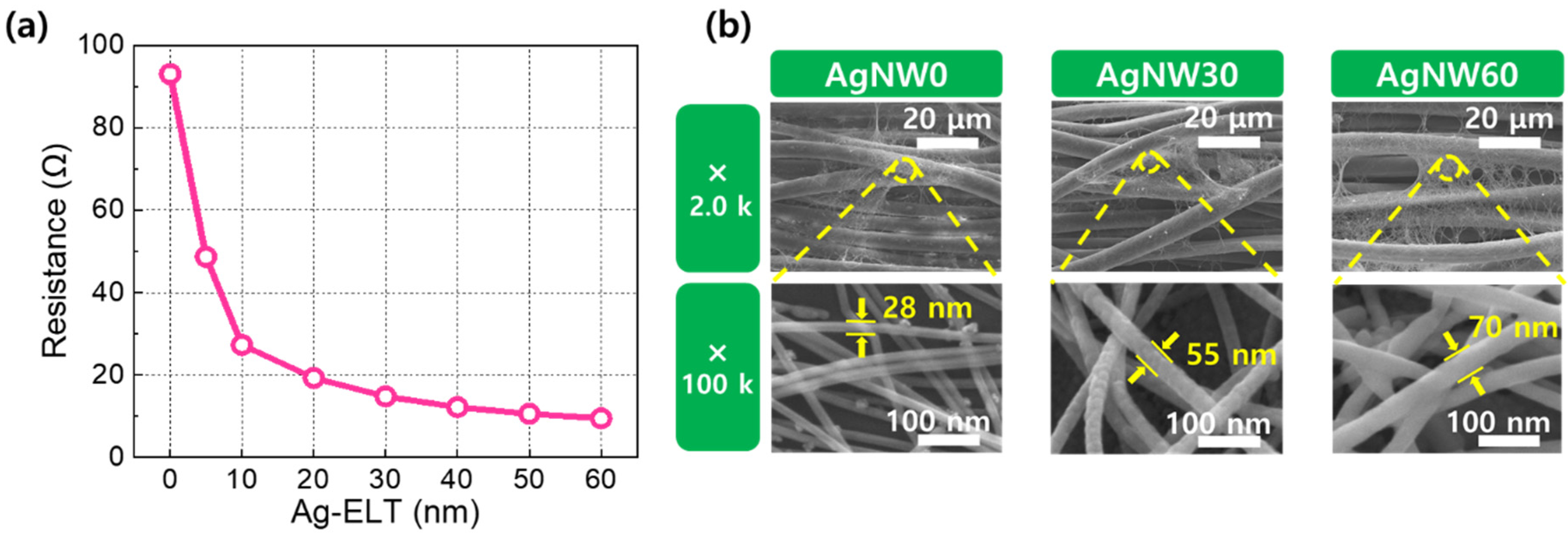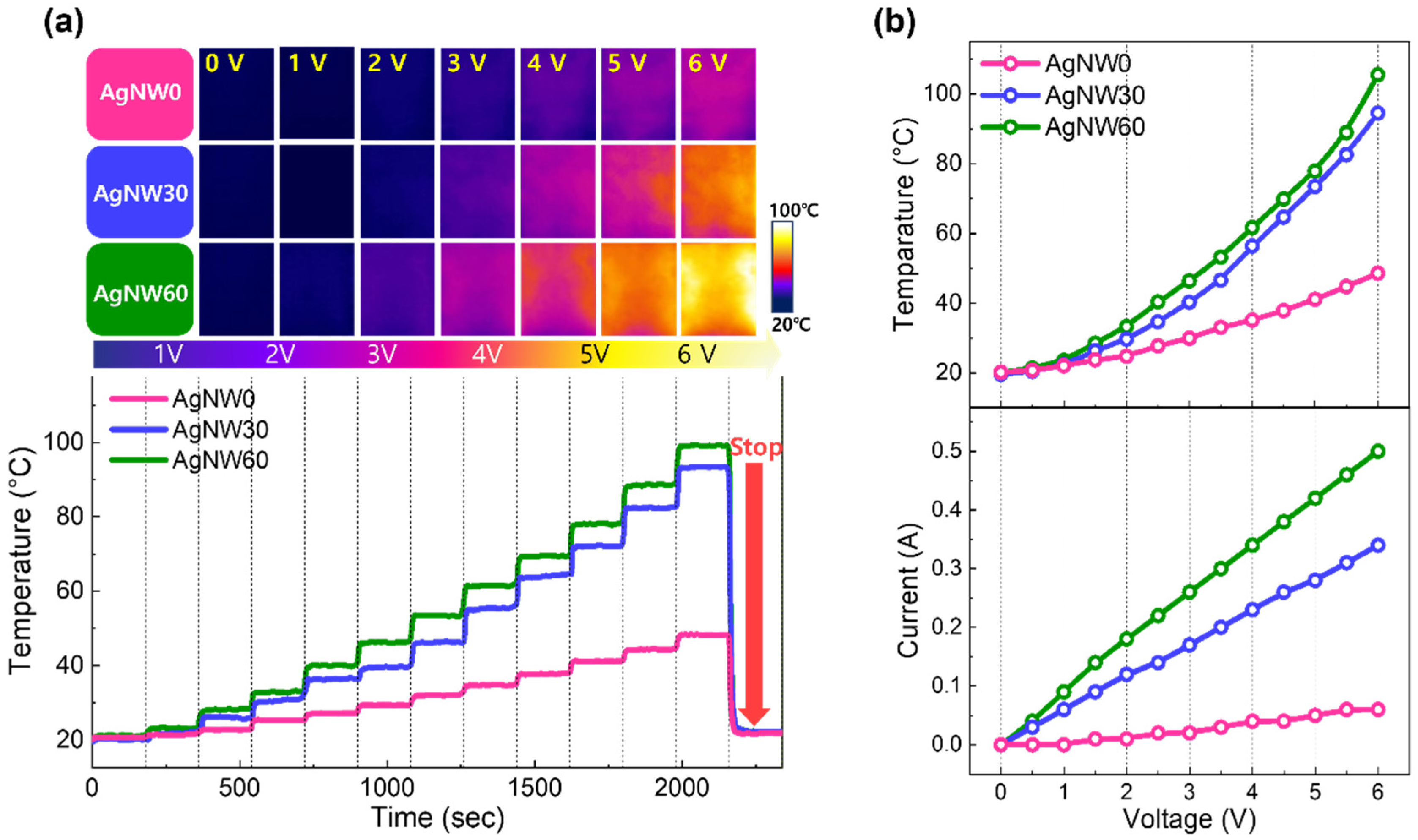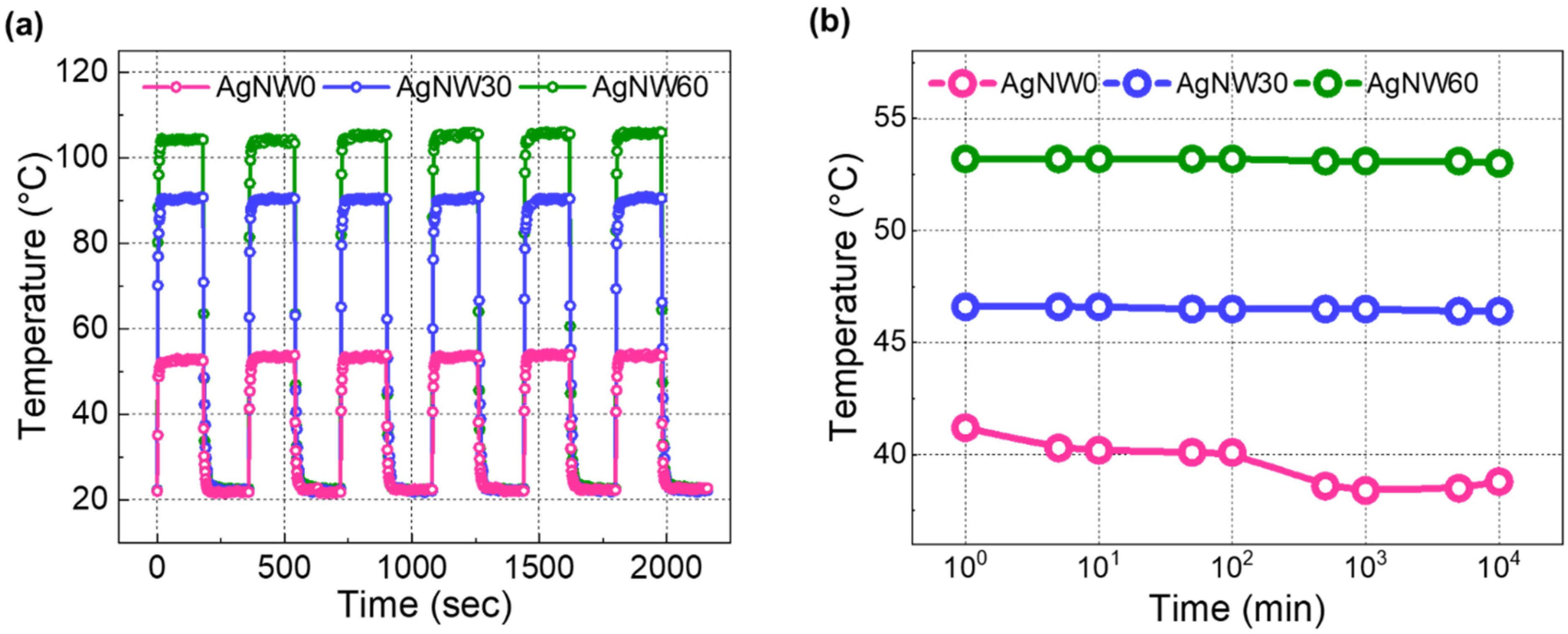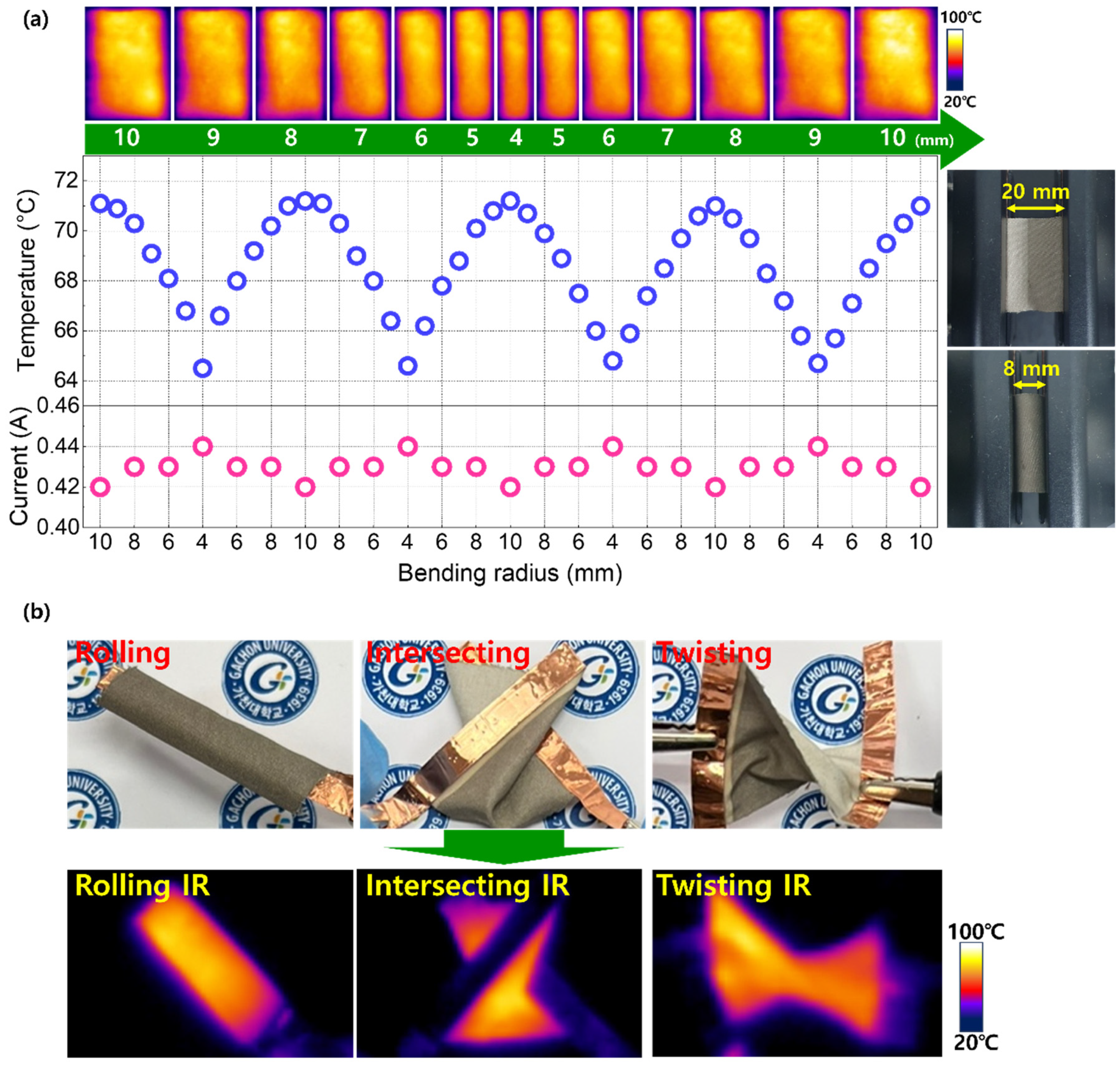Enhancing Thermoelectrical Properties of Silver-Nanowire-Embedded Heatable Textiles via Sputter-Mediated Nanowire Structural Modulation
Abstract
:1. Introduction
2. Experiment
3. Result and Discussion
4. Conclusions
Author Contributions
Funding
Institutional Review Board Statement
Informed Consent Statement
Data Availability Statement
Conflicts of Interest
References
- Libanori, A.; Chen, G.; Zhao, X.; Zhou, Y.; Chen, J. Smart textiles for personalized healthcare. Nat. Electron. 2022, 5, 142–156. [Google Scholar] [CrossRef]
- Kumar, J.; Pandit, P.; Singha, K. Recent advancements in wearable & smart textiles: An overview. Mater. Today Proc. 2019, 16, 1518–1523. [Google Scholar] [CrossRef]
- Di, J.; Zhang, X.; Young, Z.; Zhang, Y.; Li, D.; Li, R.; Li, Q. Carbon-nanotube fibers for wearable devices and smart textiles. Adv. Mater. 2013, 28, 10529–10538. [Google Scholar] [CrossRef]
- Nesenbergs, K.; Selavo, L. Smart textiles for wearable sensor networks: Review and early lessons. In Proceedings of the IEEE International Symposium on Medical measurements and Applications (MeMeA), Turin, Italy, 7–9 May 2015; pp. 402–406. [Google Scholar] [CrossRef]
- Ouyang, Z.; Li, S.; Liu, J.; Yu, H.Y.; Peng, L.; Zheng, S.; Xu, D.; Tam, K.C. Bottom-up reconstruction of smart textiles with hierarchical structures to assemble versatile wearable devices for multiple signals monitoring. Nano Energy 2022, 104, 107963. [Google Scholar] [CrossRef]
- Wang, H.; Zhang, Y.; Liang, X.; Zhang, Y. Smart fibers and textiles for personal health management. ACS Nano 2021, 15, 12497–12508. [Google Scholar] [CrossRef]
- Du, D.; Yang, X.; Yang, Y.; Zhao, Y.; Wang, Y. Silver Nanowire ink for flexible circuit on textiles. Micromachines 2019, 10, 42. [Google Scholar] [CrossRef] [PubMed]
- Atwa, Y.; Maheshwari, N.; Goldthorpe, I.A. Silver nanowire coated threads for electrically conductive textiles. J. Mater. Chem. C 2015, 3, 3908–3912. [Google Scholar] [CrossRef]
- Lian, Y.; Yu, H.; Wang, M.; Yang, X.; Li, Z.; Yang, F.; Wang, Y.; Tai, H.; Liao, Y.; Wu, J.; et al. A multifunctional wearable E-textile via integrated nanowire-coated fabrics. J. Mater. Chem. C 2020, 8, 8399–8409. [Google Scholar] [CrossRef]
- Kwon, J.; Suh, Y.D.; Lee, J.; Lee, P.; Han, S.; Hong, S.; Yeo, J.; Lee, H.; Ko, S.H. Recent progress in silver nanowire based flexible/wearable optoelectronics. J. Mater. Chem. C 2018, 6, 7445–7461. [Google Scholar] [CrossRef]
- Ahn, K.; Kim, D.; Kim, O.; Nam, J. Analysis of transparent conductive silver nanowire films from dip coating flow. J. Coat. Technol. Res. 2015, 12, 855–862. [Google Scholar] [CrossRef]
- Bruna, T.; Bravo, F.M.; Jara, P.; Caro, N. Silver nanoparticles and their antibacterial applications. Int. J. Mol. Sci. 2021, 22, 7202. [Google Scholar] [CrossRef] [PubMed]
- Wu, S.; Cui, Z.; Baker, G.L.; Mahendran, S.; Xie, Z.; Zhu, Y. A biaxially stretchable and self-sensing textile heater using silver nanowire composite. ACS Appl. Mater. Interfaces 2021, 13, 59085–59091. [Google Scholar] [CrossRef]
- Lee, S.; Shin, S.; Lee, S.; Seo, J.; Lee, J.; Son, S.; Cho, H.J.; Algadi, H.; Sayari, S.A.; Kim, D.E.; et al. Ag nanowire reinforced highly stretchable conductive fibers for wearable electronics. Adv. Mater. 2015, 25, 3114–3121. [Google Scholar] [CrossRef]
- Huynh, K.A.; Hwang, D.K.; Choi, W.J.; Lee, T.I. Near-infrared transparent transition-metal-doped indium oxide thin-film heater for LiDAR. ACS Appl. Mater. Interfaces 2024, 16, 1187–1197. [Google Scholar] [CrossRef] [PubMed]
- Nam, V.B.; Shin, J.; Choi, A.; Choi, H.; Ko, S.H.; Lee, D. High-temperature, thin, Flexible and transparent Ni-based heaters patterned by laser-induced reductive sintering on colorless polyimide. J. Mater. Chem. C 2021, 9, 5652–5661. [Google Scholar] [CrossRef]
- Bae, D.; Jung, U.; Lee, H.; Yoo, H.; Moon, S.Y.; Lee, K.H.; Kim, M.J. Synthesis of double-walled boron nitride nanotubes from ammonia borane by thermal plasma methods. ACS Omega 2023, 8, 21514–21521. [Google Scholar] [CrossRef]
- Puttaningaiah, K.P.C.H.; Ramegowda, S.D.; Hur, J. Polymer tetrabenzimidazole aluminum phthalocyanine complex with carbon nanotubes: A promising approach for boosting lithium-ion battery anode performance. ACS Appl. Energy Mater. 2024, 7, 6793–6806. [Google Scholar] [CrossRef]
- Yang, H. Research on application of carbon fiber heating materials in clothing. IOP Conf. Ser. Earth Environ. Sci. 2017, 81, 012042. [Google Scholar] [CrossRef]
- Molina, J. Graphene-based fabrics and their applications: A review. RSC Adv. 2016, 6, 68261–68291. [Google Scholar] [CrossRef]
- Shahidi, S.; Moazzenchi, B. Carbon nanotube and its applications in textile industry—A review. J. Text. Ind. 2018, 109, 1653–1666. [Google Scholar] [CrossRef]
- Gupta, R.; Rao, K.D.M.; Kiruthika, S.; Kulkarni, G.U. Visibly transparent heaters. ACS Appl. Mater. Interfaces 2016, 8, 12559–12575. [Google Scholar] [CrossRef] [PubMed]
- Papanastasiou, D.T.; Schultheiss, A.; Rojas, D.M.; Celle, C.; Carella, A.; Simonato, J.P.; Bellet, D. Transparent heaters: A review. Adv. Funct. Mater. 2020, 30, 1910225. [Google Scholar] [CrossRef]
- Wang, Y.; Wang, J.; Cao, S.; Kong, D. A stretchable and breathable form of epidermal device based on elastomeric nanofibre textiles and silver nanowires. J. Mater. Chem. C 2019, 7, 9748–9755. [Google Scholar] [CrossRef]
- Han, S.; Wan, Q.; Zhou, K.; Yan, A.; Lin, Z.; Shu, B.; Liu, C. Sensitive stretchable, and breathable pressure sensors based on medical gauze integrated with silver nanowires and elastomers. ACS Appl. Nano Mater. 2021, 4, 8273–8281. [Google Scholar] [CrossRef]
- Zhang, X.; Zhong, Y. Development of woven textile electrodes with enhanced moisture-wicking properties. J. Text. Institude 2020, 112, 1067–1079. [Google Scholar] [CrossRef]
- Farooq, A.S.; Zhang, P. Fundamentals, materials and strategies for personal thermal management by next-generation textiles. Compos. Part A Appl. Sci. Manuf. 2021, 142, 107963. [Google Scholar] [CrossRef]
- Jones, C.M.; Hoek, E.M.V. A review of the antibacterial effects of silver nanomaterials and potential implications for human health and the environment. J. Nanopart. Res. 2010, 12, 1531–1551. [Google Scholar] [CrossRef]
- Doganay, D.; Kanicioglu, A.; Coskun, S.; Akca, G.; Unalan, H.E. Silver-nanowire-modified fabrics for wide-spectrum antimicrobial applications. J. Mater. Res. 2019, 34, 500–509. [Google Scholar] [CrossRef]
- Ding, C.; Qi, N.; Zhao, B. Electronic textiles based on silver nanowire conductive network. Prog. Chem. 2017, 29, 892–901. [Google Scholar] [CrossRef]
- Wei, Y.; Chen, S.; Lin, Y.; Yuan, X.; Liu, L. Silver nanowires coated on cotton for flexible pressure sensors. J. Mater. Chem. C 2016, 4, 935–943. [Google Scholar] [CrossRef]
- Doganay, D.; Coskun, S.; Genlik, S.P.; Unalan, H.E. Silver nanowire decorated heatable textiles. Nanotechnology 2016, 27, 435201. [Google Scholar] [CrossRef] [PubMed]
- Gray, M.M.K.; Hansel, S.; Boese, M.; Krstic, V. Impact of surface and twin-boundary scattering on the electrical transport properties of Ag nanowires. Solid State Commun. 2015, 202, 48–51. [Google Scholar] [CrossRef]
- Durkan, C.; Welland, M.E. Size effects in the electrical resistivity of polycrystalline nanowires. Phys. Rev. B 2000, 61, 14215–14218. [Google Scholar] [CrossRef]
- Fuchs, K. The conductivity of thin metallic films according to the electron theory of metals. Math. Proc. Camb. Philos. Soc. 1938, 34, 100–108. [Google Scholar] [CrossRef]
- Sondheimer, E.H. The mean free path of electrons in metals. Adv. Phys. 1952, 1, 1–42. [Google Scholar] [CrossRef]
- Joo, S.H.; Choi, D.H. Numerical evaluation of grain boundary electron scattering in molybdenum thin films: A critical analysis for advanced interconnects. Vacuum 2024, 222, 1136025. [Google Scholar] [CrossRef]
- Jeong, E.; Lee, T.; Choi, D.; Yu, S.M.; Lee, S.G.; Bae, J.S.; Han, S.Z.; Lee, G.H.; Ikoma, Y.; Choi, E.A.; et al. Strategy for 564 fabricating ultrathin Au film electrodes with ultralow optoelectrical 565 losses and high stability. ACS Appl. Mater. Interfaces 2022, 14, 12797–12811. [Google Scholar] [CrossRef] [PubMed]
- Lee, T.; Kim, D.; Suk, M.E.; Bang, G.; Choi, J.; Bae, J.S.; Yoon, J.H.; Moon, W.J.; Choi, D. Regulating Ag wettability via modulating surface stoichiometry of ZnO substrates for flexible electronics. Adv. Funct. Mater. 2021, 31, 2104372. [Google Scholar] [CrossRef]
- Vo, T.T.B.; Lim, J.; Joo, S.H.; Kim, H.; Lee, T.; Bae, J.S.; Jeong, E.; Kwon, M.S.; Yun, J.; Choi, D. Smooth, chemically altered nucleating platform for abrupt performance enhancement of ultrathin Cu-layer-based transparent electrodes. Nano Lett. 2023, 23, 6528–6535. [Google Scholar] [CrossRef]





Disclaimer/Publisher’s Note: The statements, opinions and data contained in all publications are solely those of the individual author(s) and contributor(s) and not of MDPI and/or the editor(s). MDPI and/or the editor(s) disclaim responsibility for any injury to people or property resulting from any ideas, methods, instructions or products referred to in the content. |
© 2024 by the authors. Licensee MDPI, Basel, Switzerland. This article is an open access article distributed under the terms and conditions of the Creative Commons Attribution (CC BY) license (https://creativecommons.org/licenses/by/4.0/).
Share and Cite
Lee, C.; Park, J.; Choi, D. Enhancing Thermoelectrical Properties of Silver-Nanowire-Embedded Heatable Textiles via Sputter-Mediated Nanowire Structural Modulation. Materials 2024, 17, 5514. https://doi.org/10.3390/ma17225514
Lee C, Park J, Choi D. Enhancing Thermoelectrical Properties of Silver-Nanowire-Embedded Heatable Textiles via Sputter-Mediated Nanowire Structural Modulation. Materials. 2024; 17(22):5514. https://doi.org/10.3390/ma17225514
Chicago/Turabian StyleLee, Chankyoung, Jaewoo Park, and Dooho Choi. 2024. "Enhancing Thermoelectrical Properties of Silver-Nanowire-Embedded Heatable Textiles via Sputter-Mediated Nanowire Structural Modulation" Materials 17, no. 22: 5514. https://doi.org/10.3390/ma17225514
APA StyleLee, C., Park, J., & Choi, D. (2024). Enhancing Thermoelectrical Properties of Silver-Nanowire-Embedded Heatable Textiles via Sputter-Mediated Nanowire Structural Modulation. Materials, 17(22), 5514. https://doi.org/10.3390/ma17225514




